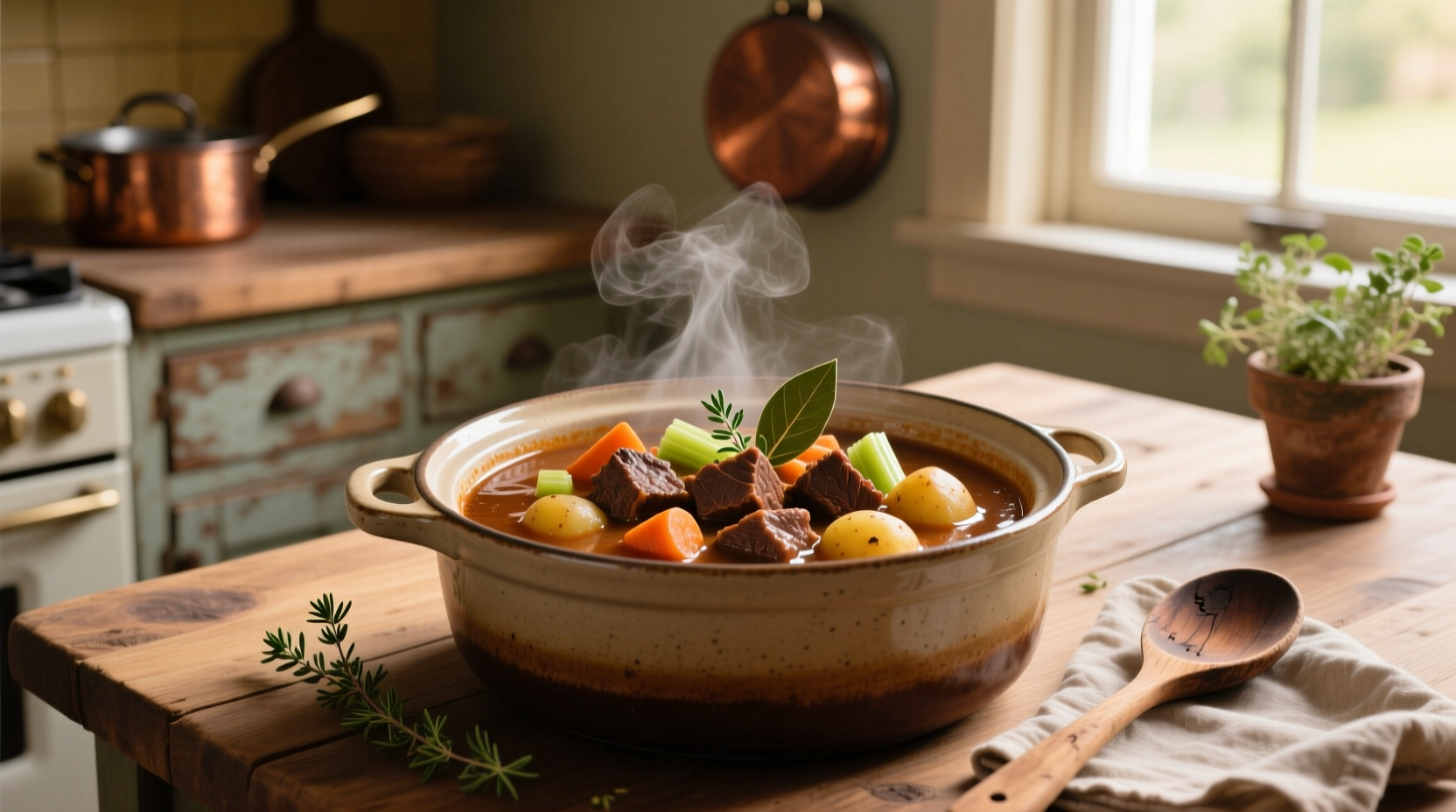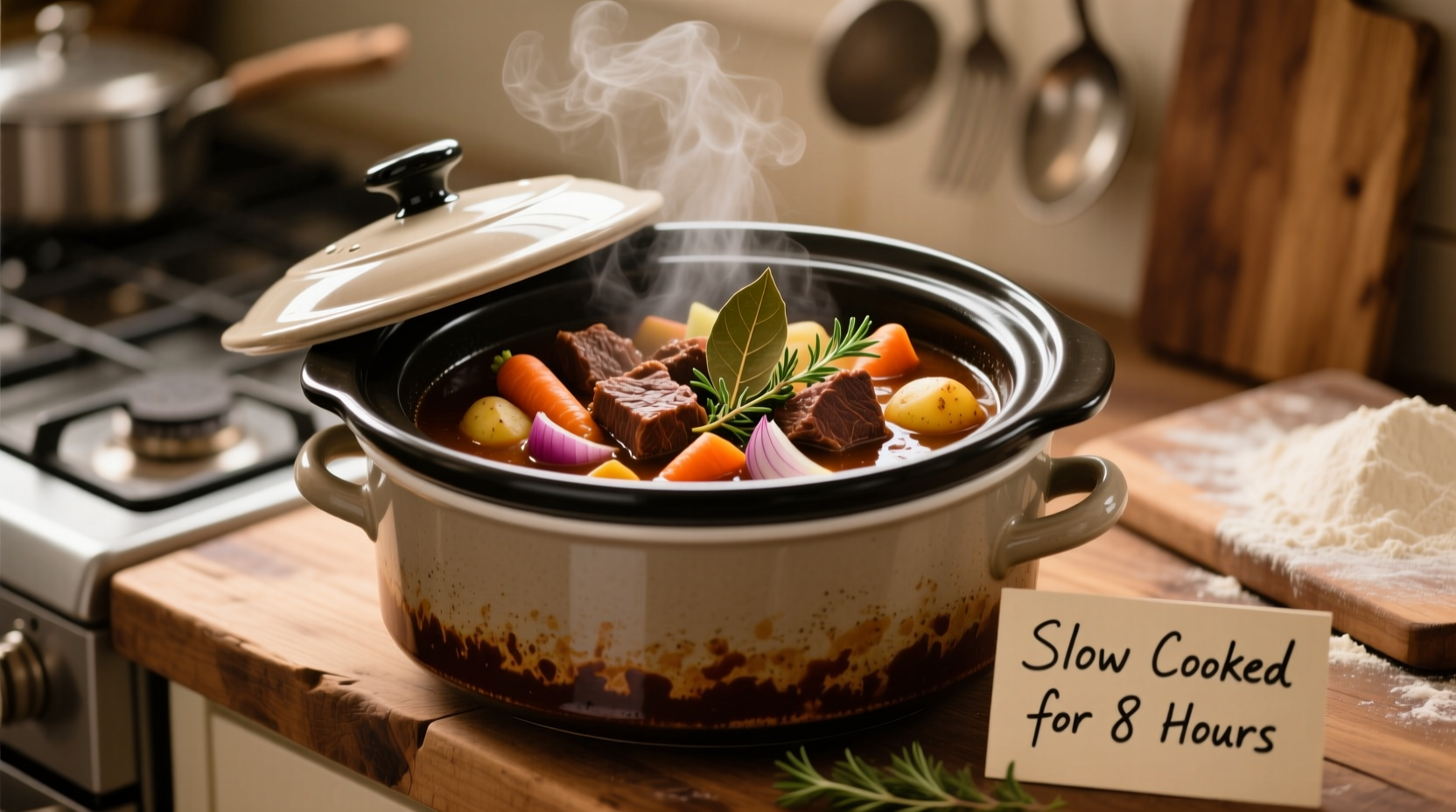To slow cook beef stew in a slow cooker, brown 2 lbs of cubed chuck roast, layer with vegetables (carrots, potatoes, onions), add 2 cups broth and seasonings, then cook on LOW for 8-10 hours or HIGH for 4-6 hours. This foolproof method guarantees tender meat and rich flavors without constant monitoring.
Why Slow Cooking Transforms Beef Stew
Slow cooking isn't just convenient—it scientifically transforms tough cuts of beef into melt-in-your-mouth perfection. When chuck roast simmers between 170-200°F (77-93°C) for 8+ hours, collagen breaks down into gelatin while fat renders slowly, creating that signature rich mouthfeel. Unlike stovetop methods that risk overcooking, slow cookers maintain precise temperatures ideal for connective tissue conversion.

Essential Equipment Checklist
Before starting, verify you have these tools:
- 5-7 quart slow cooker (oval fits meat better)
- Cast iron skillet for browning
- Sharp chef's knife and cutting board
- Meat thermometer (critical for food safety)
- Slotted spoon for fat removal
Step-by-Step Cooking Process
Prep Work: 25 Minutes
Cut 2 lbs chuck roast into 1½-inch cubes, trimming excess fat. Chop 3 carrots, 2 celery stalks, and 1 large onion into uniform 1-inch pieces. Peel and cube 1.5 lbs Yukon Gold potatoes.
Browning: The Flavor Foundation
Working in batches, sear meat in hot oil until deeply browned (2-3 minutes per side). Don't skip this step—Maillard reaction creates complex flavors no slow cooker alone can achieve. Transfer to slow cooker, leaving drippings in skillet.
Building Layers
Sauté onions in reserved drippings until translucent. Add to slow cooker with carrots, potatoes, 2 cups low-sodium beef broth, 2 tbsp tomato paste, 1 tsp thyme, 2 bay leaves, and 1 tbsp Worcestershire sauce. Never fill beyond ⅔ capacity to prevent overflow and ensure proper heat circulation.
Cooking Times & Temperatures
| Setting | Time | Internal Temp | Texture Result |
|---|---|---|---|
| LOW | 8-10 hours | 195-205°F (91-96°C) | Falls apart tender |
| HIGH | 4-6 hours | 185-195°F (85-91°C) | Firm but tender |
USDA food safety guidelines confirm beef reaches safe consumption at 145°F (63°C), but connective tissue requires 160°F+ for breakdown. Always verify final temperature reaches at least 195°F for optimal texture.
Troubleshooting Common Issues
Watery Stew Fix
If broth seems thin after cooking, remove vegetables and meat, then cook on HIGH uncovered for 30-45 minutes while stirring. The University of Minnesota Extension confirms slow cooker evaporation rates vary by model—older units may require 20% less liquid.
Tough Meat Solutions
Undercooked stew? Return to HIGH for 1-2 hours. Overcooked meat becomes stringy—next time reduce cooking time by 1-2 hours. For consistently tender results, always use chuck roast (marbling is essential) and avoid lean cuts like sirloin.
Pro Flavor Enhancements
- Add 1 oz dried mushrooms (soaked) for umami depth
- Stir in 2 tbsp red wine vinegar at the end to brighten flavors
- For richer color, dust meat with 1 tbsp flour before browning
- Add pearl onions in the last 2 hours to prevent disintegration
Storage & Reheating Guidelines
Cool completely within 2 hours (per FDA food safety guidelines). Store in airtight containers for up to 4 days refrigerated or 3 months frozen. Reheat gently on stove—microwaving makes meat tough. Flavor actually improves after 24 hours as spices meld.
Frequently Asked Questions
Can I put raw beef directly in the slow cooker without browning?
Yes, but you'll miss critical flavor development. Browning creates complex compounds through the Maillard reaction that raw cooking can't replicate. For best results, always sear meat first.
Why does my slow cooker stew turn out dry?
This usually happens when overfilling the slow cooker. Maintain the ⅔ capacity rule to allow proper steam circulation. Also verify your model isn't running hotter than standard—use an oven thermometer inside during a test run.
How do I prevent vegetables from becoming mushy?
Add root vegetables at the beginning but wait until the last 2 hours to add softer veggies like peas or zucchini. Potatoes and carrots hold up well, but delicate vegetables overcook in extended cycles.
Is 10 hours on LOW the same as 5 hours on HIGH?
No—LOW (190-200°F) and HIGH (300°F) create different results. LOW cooks more gently, yielding more tender meat. Ten hours on LOW isn't equivalent to five on HIGH; the temperature difference affects collagen breakdown rates significantly.











 浙公网安备
33010002000092号
浙公网安备
33010002000092号 浙B2-20120091-4
浙B2-20120091-4